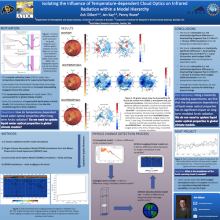Isolating the Influence of Temperature-dependent Cloud Optics on Infrared Radiation within a Model Hierarchy
Ash
Gilbert
University of Colorado-Boulder
Poster
Clouds exert strong influences on surface energy budgets and climate projections. Yet, cloud physics is complex and often incompletely represented in models. For example, temperature-dependent cloud optics parameterizations are rarely incorporated into the radiative transfer models used for future climate projections. In regions with frequent supercooled liquid clouds, we hypothesize incorporating temperature-dependent cloud optics will increase downwelling surface infrared radiation at the surface. Here, we test this hypothesis with a model hierarchy. In two-stream radiation and single-column models, incorporating temperature-dependent optical properties had a negligible impact. Similarly, impacts were insignificant on infrared radiation within freely evolving atmospheric model simulations. Finally, we isolated a signal due to these optics changes by nudging winds within our atmospheric model experiments towards observed (reanalysis) winds. These wind-nudging experiments help to isolate the signal from temperature-dependent cloud optics changes by reducing the internally generated atmospheric variability. In summary, we found a signal from temperature-dependent optics, but this signal is small compared to climate variability and therefore unlikely to be important for climate projections. More broadly, this work demonstrates a framework for assessing the climate importance of a physics change within a model hierarchy.

gilbert-ash-polar-poster.pdf
(8.15 MB)
